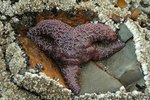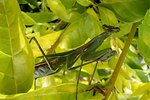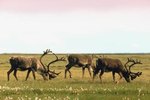The saiga is a strange-looking antelope in the gazelle family, which lives in Kazakhstan and nearby areas. It is extremely endangered due to poaching and environmental destruction, but in its natural habitat it is a migrating herbivore that eats over 100 different types of plants.
Migration and Feeding
The saiga's normal migration pattern is to head up into the steppes in the summer to enjoy the bountiful grasses. In the winter it heads back down to the deserts, where plants may be more rare, but there is also much less snow. The saiga fills a unique ecological niche by grazing on plants that are unpalatable to many other animals, including lichens, grass, cypress, saltworts, fobs and sage grass.
Adaptation
Besides being able to survive by eating plants that are poisonous to many other species, the saiga has several other handy adaptations. Its most distinctive feature is its hooked and bulbous nose, which it uses to navigate extreme conditions. The large nose is filled with hair and mucous glands that help to warm the air it breathes during the frigid winters and filter out dust during the desert season. The saiga also has strong, thin legs that allow it to travel far and fast during its wide migrations.
Endangered Species
The saiga used to be a very common animal, well adapted to a diet of plants in any region from Europe to Alaska. However, its populations have been dramatically reduced by hunting, especially since the breakdown of the USSR, which used to help regulate populations. As of 2008, saiga were placed on the International Union for Conservation of Nature's critically endangered list, but are still poached, especially because their horns are sometimes used as remedies in traditional Chinese medicine. To make matters worse, their habitat has been reduced by construction, and despite their broad dietary preferences food is becoming scarcer.
Conservation
However, things may be looking up for the saiga. The government of Kazakhstan has designated a nature preserve within its range, and conservation organizations around the world are taking an interest in its plight. Under normal conditions the saiga's rate of reproduction is high enough to increase its population as much as 60 percent in a single year, and because of its diverse diet it can thrive in many habitats. So with greater protection saiga may once again fulfill their unique ecological function soon.
References
Writer Bio
Laura Gee has a B.A. in history and anthropology, but now spends more time blogging and producing web content. She has worked and/or trained as an illustrator, crafter, caterer, yoga teacher, child-care provider and massage therapist, and she loves to travel when she gets a chance.





